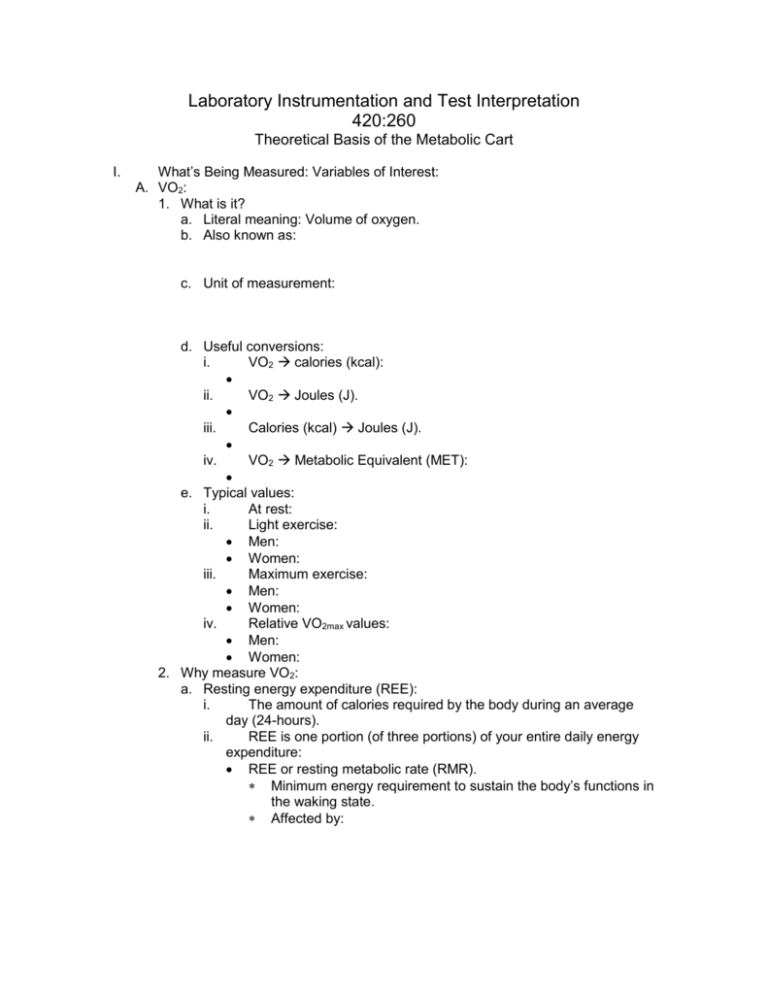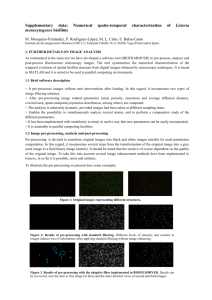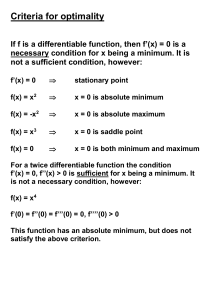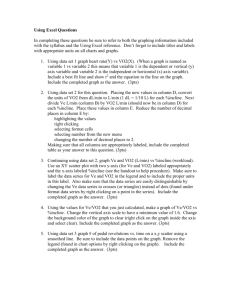Metabolic Cart
advertisement

Laboratory Instrumentation and Test Interpretation 420:260 Theoretical Basis of the Metabolic Cart I. What’s Being Measured: Variables of Interest: A. VO2: 1. What is it? a. Literal meaning: Volume of oxygen. b. Also known as: c. Unit of measurement: d. Useful conversions: i. VO2 calories (kcal): ii. VO2 Joules (J). iii. Calories (kcal) Joules (J). iv. VO2 Metabolic Equivalent (MET): e. Typical values: i. At rest: ii. Light exercise: Men: Women: iii. Maximum exercise: Men: Women: iv. Relative VO2max values: Men: Women: 2. Why measure VO2: a. Resting energy expenditure (REE): i. The amount of calories required by the body during an average day (24-hours). ii. REE is one portion (of three portions) of your entire daily energy expenditure: REE or resting metabolic rate (RMR). Minimum energy requirement to sustain the body’s functions in the waking state. Affected by: iii. RMR accounts for ~60-75% of REE. Thermic effect of metabolism (TEM): Energy cost for digesting, absorbing and assimilating food. Thermic effect of feeding accounts for ~10% of REE. Thermic effect of physical activity: Energy cost of all daily activities. Thermic effect of physical activity accounts for ~15-30% of REE. Why measure REE: b. Energy cost of physical activity: i. The amount of energy required to perform any given task during steady state. ii. Need to remember to subtract the REE from energy cost of exercise. c. Aerobic power (VO2max): i. The maximum rate of oxygen consumption. ii. Measure of cardiovascular fitness. iii. Determinants of VO2max include: B. Respiratory Exchange Ratio (RER): 1. What is it? a. The ratio of CO2 produced to O2 consumed (CO2 produced/O2 consumed). i. Formula: b. RER is important when determining REE as well as enabling the researcher to determine the nutrient mixture being metabolized. i. Carbohydrate ii. Fat iii. Protein c. In reality, we are using a combination of all three macronutrients therefore an intermediate RER between 0.70 and 1.0 will be found. C. Minute Ventilation (VE): 1. What is it? a. The volume of air breathed in one minute. i. Formula: 2. Unit of measurement: 3. Typical values: a. Quiet breathing at rest: b. Maximal exercise: i. Average adult: ii. Well trained endurance athlete: iii. Elite: Note: Maximum tidal volume only reaches 55-60% of vital capacity! II. The Metabolic Calculations: A. Open Circuit Indirect Calorimetry: 1. Open Circuit: 2. Indirect: 3. Calorimetry: B. The Raw Data: 1. Recall the variables that are measured: a. VO2: Volume of O2 consumed. b. VCO2: Volume of CO2 produced. c. RER: Ratio of VCO2:VO2. d. VE: Minute ventilation amount of air breathed in one minute. 2. New variables: a. FiO2, FiCO2 and FiN2: The fraction (percentage) of inspired O2 CO2 or N2. i. These are constants: FiO2 = 20.93% or 0.2093 FiCO2 = 3.03% or 0.0303 FiN2 = 79.04% or 0.7904 b. FeO2, FeCO2 and FeN2: The fraction (percentage) of expired O2 CO2 or N2. C. Standardization of the Environment: 1. The volume of any gas is affected by three factors: a. Temperature: b. Barometric Pressure: c. Water Vapor: 2. When attempting to make meaningful comparisons between data that involves gas volumes, these three factors must be considered. That is, a frame of reference is needed in order to make meaningful comparisons. This frame of reference is referred to as: a. STPD: Standard conditions of: i. Temperature: ii. Pressure: iii. Dry air b. All metabolic calculations are to be expressed as STPD. D. Metabolic Calculations: Based on 1 minute of breathing. 1. Brief over view of the steps: a. Step 1: Standardization Calculation of the STPD conversion factor. b. Step 2: VE(STPD) Minute ventilation at STPD Calculation the amount of air expired in one minute at STPD. c. Step 3: VEO2 Calculate the amount of O2 expired in one minute. d. Step 4: VI(STPD) Inspired air at STPD Calculate the amount of air inspired in one minute at STPD. e. Step 5: VIO2 Calculate the amount of O2 inspired in one minute. f. Step 6: VO2 Oxygen consumption Calculate amount of O2 consumed. g. Step 7: VCO2 h. Step 8: RER i. Step 9: Additional calculations Relative VO2, calories burned. 2. Step 1: Calculate the STPD conversion factor: a. What do you need to know? i. Ambient temperature in C. ii. Barometric pressure (PB): The pressure in the earth’s atmosphere caused by the weight of air. Primarily affected by altitude. Check the barometric pressure in the lab and use the provided table to correct it for temperature. iii. Water vapor pressure (PH20): Use Table 15.6 (Adams Lab Manual, 2002) to get the PH20 at any given ambient temperature. Multiply this value by the relative humidity (RH) to get the corrected PH20. Example: At 21 C the PH20 is 19 mmHG. If the RH was 50% (0.50 x 19 = 9.5 mmHG). b. STPD = (273 / 273 + Temp C) (PB – PH20 / 760 mmHG) 3. Step 2: Convert the minute ventilation (VE) to STPD. Amount of air expired during the one minute of breathing. a. VE(STPD) = 4. Step 3: Calculate the volume of oxygen that was expired during the one minute of air expiration (VEO2). a. VEO2 = 5. Step 4: Calculate the volume of air (not oxygen) that was inspired at STPD: a. VI(STPD) = 6. Step 5: Calculate the volume of oxygen that was inspired during the one minute of breathing (VIO2). a. VIO2 = 7. Step 6: Calculate the volume of oxygen consumed (VO2): a. VO2 = 8. Step 7: Calculate VCO2: a. VCO2 = 9. Step 8: Calculate RER: a. RER = 10. Step 9: Perform additional calculations: a. Calculate relative VO2 (ml/kg/min) i. Relative VO2 = VO2 * body weight (kg) / 1000 b. Calculate calories burned per minute (assuming steady state): i. Calculate calories burned based on RER ii. Kcal/min = VO2 * ~5 III. Introduction to the Instrument (2900 Sensormedics Metabolic Cart):






